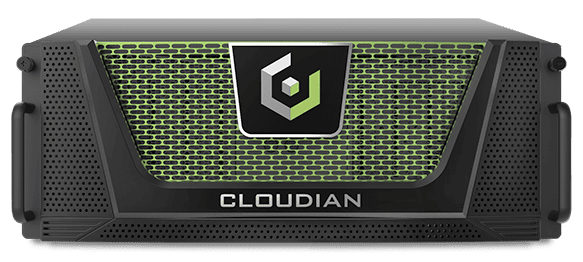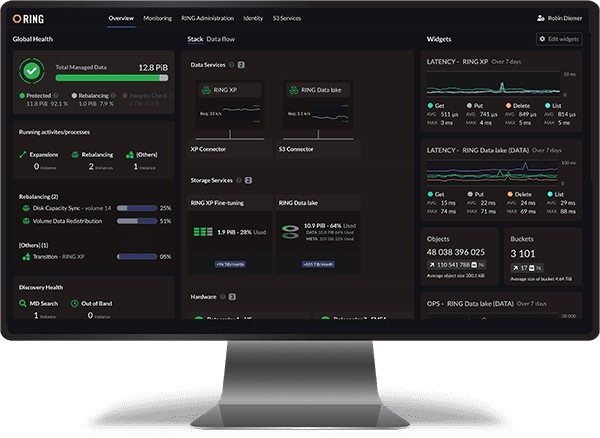Request a Demo
Join a 30 minute demo with a Cloudian expert.
Object storage solutions store and manage large volumes of unstructured data. Unlike traditional file or block storage, object storage organizes data as discrete units called objects, each containing the data itself, associated metadata, and a unique identifier. This architecture allows for massive scalability, making it suitable for situations where data volumes can rapidly grow, such as cloud storage, backup and recovery, and big data analytics.
These solutions eliminate the hierarchical structure found in file systems. Instead, they use a flat namespace, which simplifies management and retrieval for large datasets. Object storage is accessed through standard APIs, such as S3, and is typically designed to ensure high durability and availability through mechanisms like replication and erasure coding.
In this article:
Understanding the core components of object storage helps clarify how these systems manage and scale unstructured data. Here are the key elements that enable object storage to deliver performance, durability, and ease of access across a wide range of use cases.

Cloudian HyperStore Object Storage Software is an enterprise-grade, software-defined storage platform designed for managing massive volumes of unstructured data at scale. Built for AI-ready performance and secure, hybrid-cloud integration, HyperStore empowers organizations to maintain full data sovereignty while delivering high throughput and bulletproof ransomware protection. With seamless S3 API compatibility and unified file-object storage, it supports capacity-intensive workflows—like AI/ML, data analytics, and backup/archival—while offering flexible deployment options on commodity hardware or Cloudian appliances.
Key features include:


Nutanix Objects Storage is a software-defined, S3-compatible object storage solution for secure hybrid cloud operations. It enables enterprises to consolidate their unstructured data—such as backups, archives, and cloud-native application data—into a single platform. The system is deployed on Nutanix AOS, either within existing clusters or across multiple clusters.
Key features include:


Scality RING is a software-defined object storage platform for hybrid and private cloud environments. It is optimized for unstructured data workloads such as backup, archival, video content management, and big data analytics. RING provides native support for object and file storage, enabling organizations to consolidate their storage infrastructure.
Key features include:


Quantum ActiveScale is a software-defined object storage platform to manage active and cold data. It provides a unified, S3-compatible storage environment for data lakes, AI training pipelines, private clouds, and hybrid cloud deployments. ActiveScale allows organizations to consolidate unstructured data across multiple storage classes and formats.
Key features include:


Dell ObjectScale is a Kubernetes-native object storage platform to support cloud-native applications and scalable multi-cloud deployments. Designed for containerized environments, ObjectScale integrates with Kubernetes orchestration and runs on Dell’s PowerScale, PowerFlex, or customer-selected infrastructure.
Key features include:

Organizations should consider these practices to ensure an effective object storage strategy.
Effective object storage begins with a plan for the entire data lifecycle, from ingestion through retention, retrieval, and eventual deletion. Organizations should define clear policies for data classification, retention schedules, archival, and compliance. These policies control storage costs and ensure that aging or obsolete data does not clutter the environment, improving search and retrieval efficiency.
Mapping out the data lifecycle also involves anticipating organizational changes—such as regulatory adjustments or business expansion—that could impact storage requirements. Regularly reviewing and updating lifecycle policies ensures that the storage environment remains aligned with business objectives, legal obligations, and evolving data privacy regulations.
Automation is essential for maintaining efficient, large-scale object storage environments. Automated workflows can handle repetitive tasks such as policy enforcement, replication, tiering, and object deletions according to predefined rules. This reduces human error, simplifies management, and frees up IT teams to focus on strategic initiatives rather than manual operations.
Orchestration tools further enable integration with broader IT systems and processes. By linking object storage to data pipelines, backup systems, and cloud services, orchestration ensures that storage responds dynamically to changes in workloads and business needs. Using API-driven automation and orchestration also supports rapid scaling and recovery.
Monitoring is a non-negotiable element of object storage management. Real-time, granular monitoring allows organizations to track storage usage, latency, API calls, capacity trends, and system health. Modern object storage platforms offer built-in dashboards and the ability to integrate with third-party observability tools, providing visibility into both day-to-day operations and long-term trends.
Alerting complements monitoring by notifying administrators of issues like hardware failures, replication lag, or unauthorized access. Effective alerting systems enable rapid response and remediation, helping maintain data availability and compliance with service-level agreements. Customizable thresholds and escalation mechanisms ensure that critical incidents are prioritized.
Metadata is crucial for the function and performance of object storage, as it governs how data is indexed, searched, and retrieved. Ensuring metadata consistency is essential for maintaining data integrity across distributed environments. Organizations should establish strict protocols for metadata management, including regular audits, validation routines, and synchronization processes between storage nodes.
Consistent metadata guarantees reliable search, access control, and policy enforcement. Inconsistent or corrupted metadata can lead to data inaccessibility, security risks, or operational failures. Using automated tools for metadata health checks and correction can mitigate these risks, improve auditability, and support efficient data governance at scale.
Organizations should schedule routine reviews of their object storage security policies to account for evolving threats, compliance standards, and operational changes. These reviews should cover access controls, encryption settings, user permissions, and integration with identity management systems, ensuring that security is not compromised as environments change.
Updating and testing security measures regularly helps identify vulnerabilities, enforce least-privilege access models, and ensure effective response mechanisms exist for breaches or incidents. Documentation and audit trails should be maintained to track policy changes and demonstrate compliance. Security reviews should be a formal, recurring process.
Implementing object storage enables organizations to efficiently manage and protect rapidly growing unstructured data. By leveraging the inherent scalability, durability, and API-driven access of object storage solutions, teams can optimize data workflows and ensure long-term value from their information assets. A thoughtful approach to architecture, automation, monitoring, metadata management, and security creates a resilient storage environment.